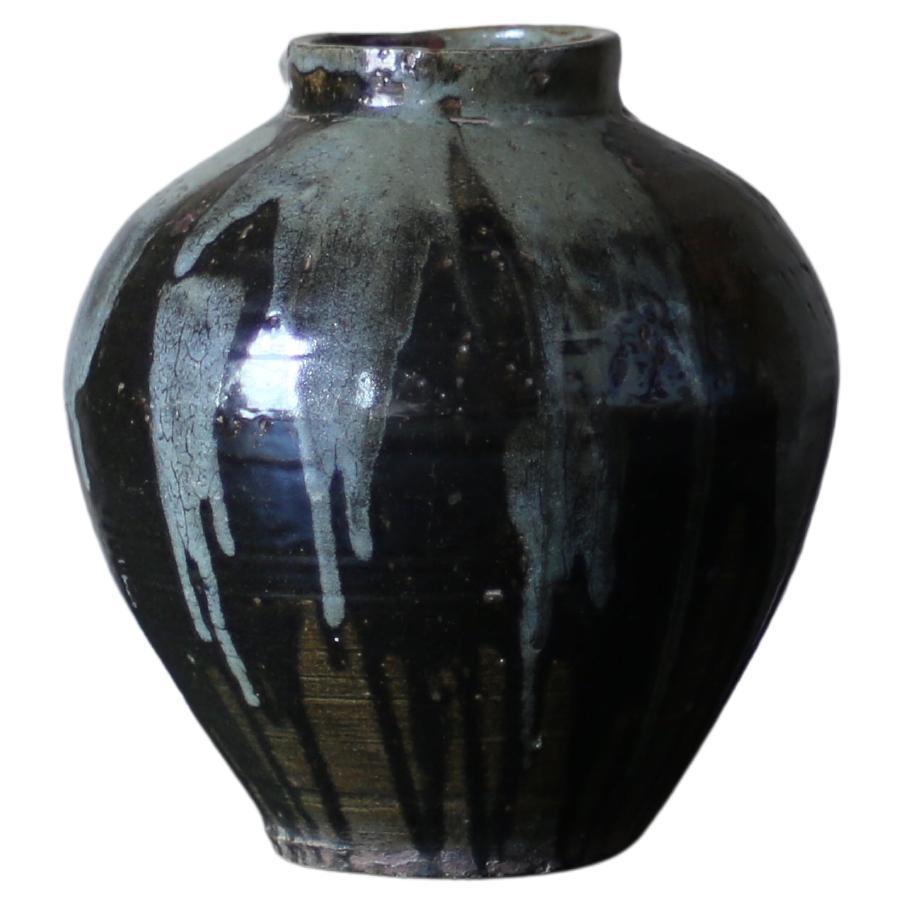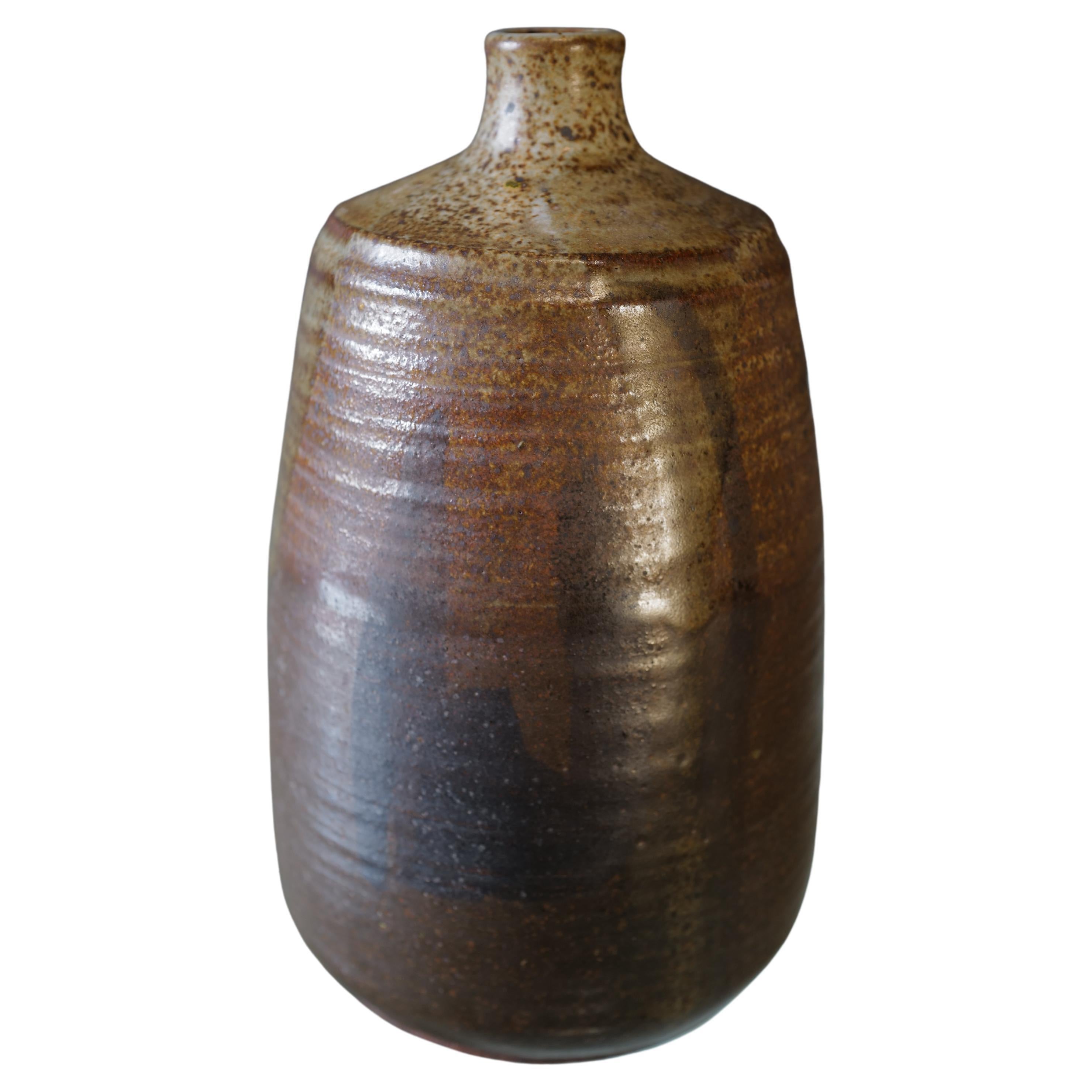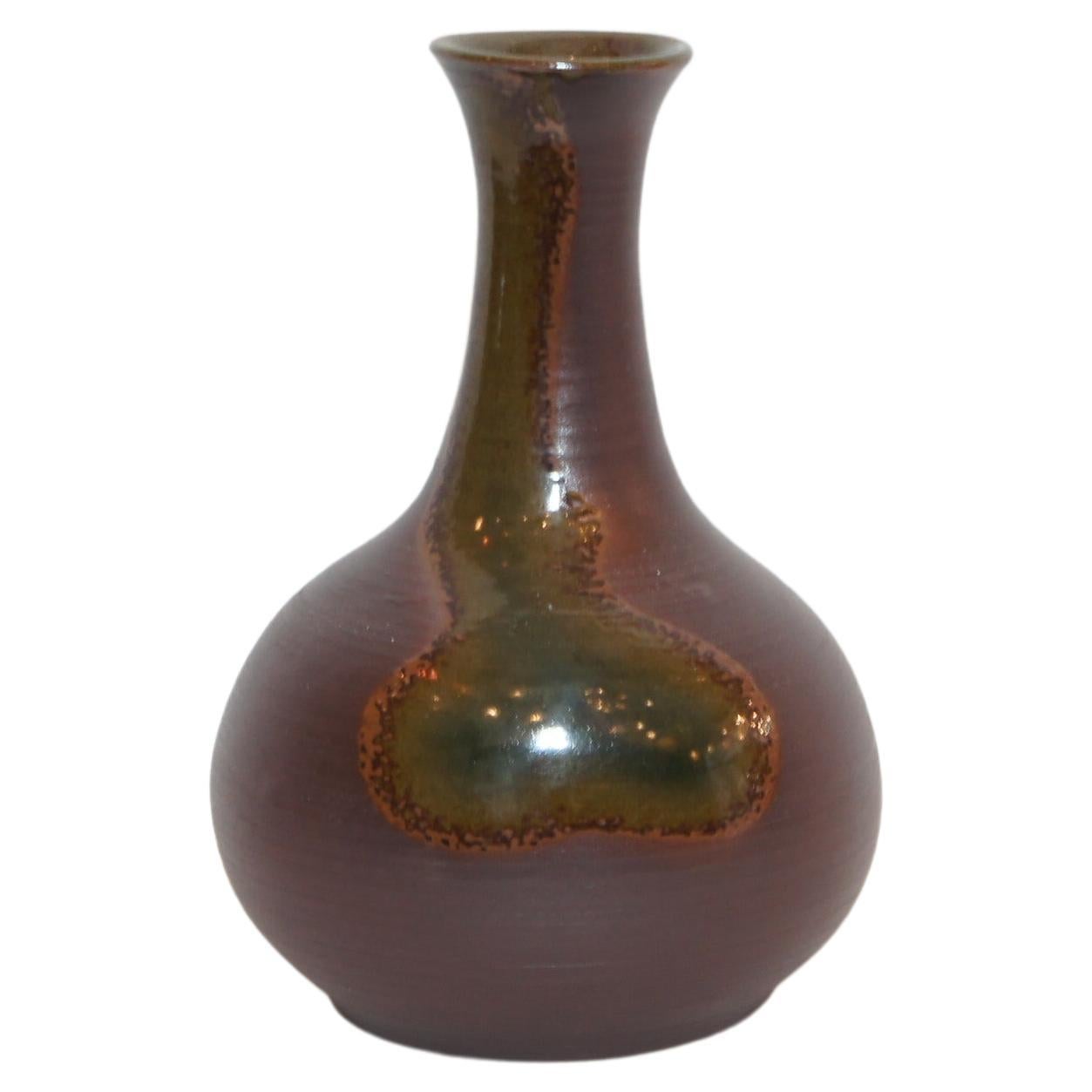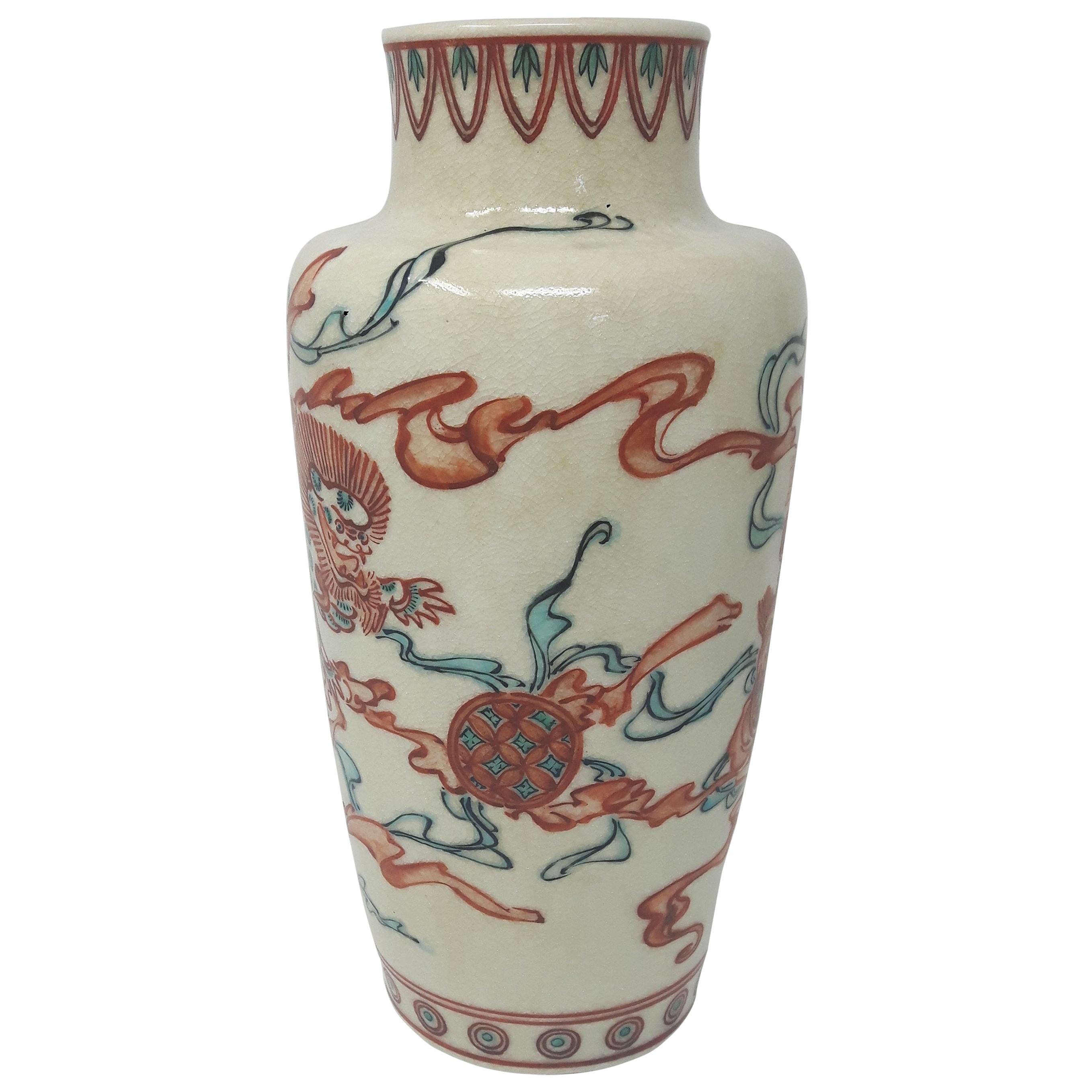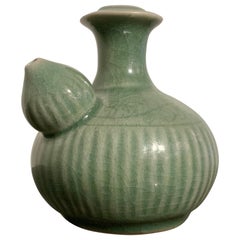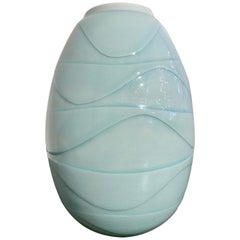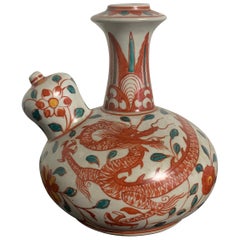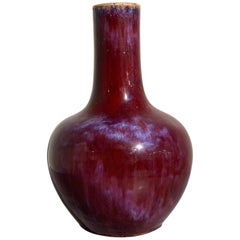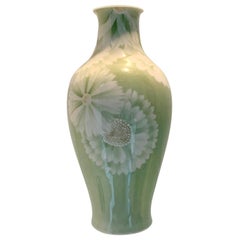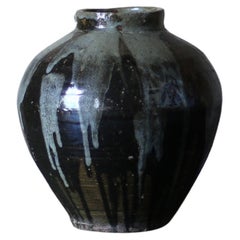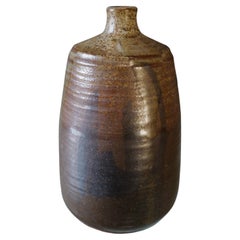Items Similar to Miyanaga Tozan III Seihakuji Glazed Tokkuri, Showa Era, Japan
Want more images or videos?
Request additional images or videos from the seller
1 of 17
Miyanaga Tozan III Seihakuji Glazed Tokkuri, Showa Era, Japan
$6,800
£5,191.77
€5,999.04
CA$9,545.91
A$10,639.91
CHF 5,582.40
MX$129,930.70
NOK 70,685.30
SEK 66,808.36
DKK 44,773.48
About the Item
A sublime and elegant seihakuji (qingbai or celadon) glazed porcelain tokkuri (sake bottle) by Miyanaga Tozan III, also known as Miyanaga Rikichi, (b. 1935), Showa Period, circa 1980's, Japan.
The sake bottle, called a tokkuri, is delicately potted of fine porcelain and glazed all over in a subtle pale blue green celadon glaze known as seihakuji (called qingbai in China). The thin, nearly transparent glaze is luminous, evoking water or moonlight.
Contrasting beautifully with the subtleness of the glaze is the bold and unexpected spiraling design that seems to torque the bottle, underscoring the potter's masterful understanding of clay, geometry, and form. Five raised lines descend straight down the neck from the mouth of the bottle before turning elegantly and dramatically at the shoulder, straightening again down the sides, and turning once again just above the foot. The raised ridges of the lines barely hold the thin seihakuji glaze, revealing the pure white porcelain below.
The tokkuri of somewhat typical shape, with an ovoid body, squared shoulders, tall, narrow neck, and elegantly everted mouth, all set on a short recessed foot.
Holding the bottle is a joy. The ridges are unexpectedly smooth. The glaze has a soft and supple feel. And the bottle seems to conform to one's hands. Looking down into the mouth, the twisted lines almost feel like swirling water, creating a whirlpool effect. A similar and even stronger effect is achieved while viewing the foot.
The bottle with an inscribed signature to the underside reading "Ri" (for Rikichi) with a collection number in ink. The tokkuri comes with the original signed tomobako. The exterior of the lid inscribed "Seihakuji" and "Tokkuri". The interior of the lid signed "Miyanaga Rikichi saku" and sealed.
Kyoto based potter Miyanaga Tozan III (b. 1935) was previously known as Miyanaga Rikichi before taking over his father's mantle in 1999. Part of the second generation of avant-garde ceramicists, he is the third in a line of celebrated and accomplished ceramicists, beginning with his grandfather, Tozan I (1868 - 1941). His daughter, Miyanaga Aiko, is set to eventually take over the family kiln.
Provenance: Christie's Japanese and Korean Art, March 24, 2003, lot 201.
For a vase from the same series, please see lot 1123 from the Sotheby's September 2023 sale, Freddie Mercury: A World of His Own / In Love with Japan
- Dimensions:Height: 7.5 in (19.05 cm)Width: 4.75 in (12.07 cm)Depth: 4.75 in (12.07 cm)
- Style:Showa (Of the Period)
- Materials and Techniques:
- Place of Origin:
- Period:1980-1989
- Date of Manufacture:circa 1980's
- Condition:Wear consistent with age and use. In fine condition, with no chips, cracks, or repairs. The wooden tomobako missing one bar to the interior of the cover.
- Seller Location:Austin, TX
- Reference Number:1stDibs: LU894736936232
About the Seller
5.0
Platinum Seller
Premium sellers with a 4.7+ rating and 24-hour response times
Established in 2001
1stDibs seller since 2010
345 sales on 1stDibs
Typical response time: <1 hour
- ShippingRetrieving quote...Shipping from: Austin, TX
- Return Policy
Authenticity Guarantee
In the unlikely event there’s an issue with an item’s authenticity, contact us within 1 year for a full refund. DetailsMoney-Back Guarantee
If your item is not as described, is damaged in transit, or does not arrive, contact us within 7 days for a full refund. Details24-Hour Cancellation
You have a 24-hour grace period in which to reconsider your purchase, with no questions asked.Vetted Professional Sellers
Our world-class sellers must adhere to strict standards for service and quality, maintaining the integrity of our listings.Price-Match Guarantee
If you find that a seller listed the same item for a lower price elsewhere, we’ll match it.Trusted Global Delivery
Our best-in-class carrier network provides specialized shipping options worldwide, including custom delivery.More From This Seller
View AllSmall Chinese Celadon Glazed Porcelain Kendi, Qing Dynasty, 18th Century, China
Located in Austin, TX
A darling small Chinese celadon glazed kendi, or pouring vessel, mid Qing Dynasty, 18th century, China, for the Southeast Asian market.
The diminutive kendi of typical form, with ...
Category
Antique 18th Century Chinese Qing Ceramics
Materials
Porcelain
Ono Kotaro Seihakuji Glazed Vase, Heisei Era, circa 2000
Located in Austin, TX
A subtle and finely potted seihakuji glazed vase by Japanese contemporary ceramicist Ono Kotaro (b. 1953), circa 2000.
Ono Kotaro is known for balancing...
Category
Late 20th Century Japanese Ceramics
Materials
Porcelain, Cedar
Chinese Export Kendi, Swatow Ware, Porcelain with Polychrome Enamels, circa 1900
Located in Austin, TX
A delightful Swatow ware Chinese export shipwreck porcelain kendi featuring a writing dragon and an apocryphal Tongzhi mark, late 19th or early 20th centur...
Category
Antique Early 1900s Chinese Qing Ceramics
Materials
Porcelain
Chinese Qing Dynasty Flambé Glazed Bottle Vase, Tianqiuping, Late 19th Century
Located in Austin, TX
A gorgeous Chinese monochrome red flambé glazed bottle vase, called a tianqiuping, Qing Dynasty, late 19th century.
The voluptuous body o...
Category
Antique Late 19th Century Chinese Qing Vases
Materials
Porcelain
Korean Carved Celadon Vase, Maebyeong, Goryeo Style, Early 20th Century
Located in Austin, TX
A wonderful Korean celadon vase, called a maebyeong, in the Goryeo style, but of early 20th century manufacture.
The maebyeong vase with a beaut...
Category
Early 20th Century Korean Ceramics
Materials
Stoneware
Chinese Blue Flambe Glazed Hu Vase, Qing Dynasty, 19th Century, China
Located in Austin, TX
An unusual and spectacular Chinese monochrome blue flambé-glazed hu form porcelain vase, Qing Dynasty, 19th century, China.
The hu vase is heavily potted with elegant proportions...
Category
Antique Early 19th Century Chinese Qing Ceramics
Materials
Porcelain
You May Also Like
Japanese Porcelain Vase Meiji Period Makuzu Kozan
By Makuzu Kozan
Located in Atlanta, GA
A finely decorated and glazed Japanese porcelain vase by Makuzu Kozan (1842-1916) circa 1900s Meiji Period. The vase is of a classic bottle form with baluster body and short neck. It was decorated with underglaze white magnolia blossom on a pleasant celadon background. The stamens of the flower were artistically rendered in a low relief, giving the design a realistic appeal with the dimension.
Miyagawa Kozan...
Category
Early 20th Century Japanese Meiji Ceramics
Materials
Porcelain
Japanese Antique Pottery Vase 1900s-1940s / Kasama
Located in Sammu-shi, Chiba
This ceramic vase was made in Kasama, Japan. Kasama is a traditional and famous pottery producing area.
It is very old vase.
It has a very beautiful light blue glaze and has a wond...
Category
Early 20th Century Japanese Taisho Vases
Materials
Pottery
Japanese Ceramic Pottery
Located in Oklahoma City, OK
Experience the timeless beauty of Japanese craftsmanship with this exquisite ceramic pottery vase. Meticulously handcrafted by skilled artisans, this vase showcases the rich artistic traditions of Japan.
The vase features a sleek and elegant design, with smooth curves and clean lines that exude a sense of understated sophistication. Its graceful form captures the essence of minimalism, creating a harmonious balance between simplicity and elegance.
Crafted from high-quality ceramic, this vase boasts a stunning glaze that accentuates its unique texture and adds a touch of depth to its surface. The glaze beautifully reflects light, creating a mesmerizing play of colors that enhances the overall aesthetic appeal.
Embracing the principles of wabi-sabi, a Japanese philosophy that embraces imperfections and celebrates the beauty of nature, this vase showcases subtle irregularities that make it one-of-a-kind. Each delicate brushstroke and subtle variation in color and tone tells a story, adding a sense of authenticity and charm to the piece.
Whether displayed as a standalone art object or adorned with a carefully arranged bouquet of flowers, this Japanese ceramic pottery...
Category
20th Century Japanese Mid-Century Modern Vases
Materials
Ceramic
Bicone Vase by U-Turn Ushiro
Located in Sammu-shi, Chiba
Bicone vase by U-Turn Ushiro.
It is baked for several days in an anagama (a kiln that burns firewood).
It is shaped vertically symmetrically. The copper contained in the clay blows out on the surface, and reddish-black spots can be seen partially. It is a work where you can see various reactions of various ingredients.
U-Turn Ushiro
While working at the fire station...
Category
2010s Japanese Japonisme Ceramics
Materials
Pottery
Japanese Antique Flower Vase Tokoname Ware 1970s
Located in Paris, FR
This is a flower vase made around 1970s and with style Tokoname.
Tokonane Yaki is the oldest and the most important ceramic center of the six ancient kilns of Japan.
Tokonane Yaki is the oldest and the most important ceramic center of the six ancient kilns of Japan with Shigaraki, Bizen, Tanba, Echizen and Seto. Ceramic is produced there since the end of the Heian periode (11th century).
Tokoname-yaki (Tokoname ware...
Category
Vintage 1970s Japanese Vases
Materials
Porcelain
Unusual Early 20th Century Makuzu Kozan Vase
By Makuzu Kozan
Located in London, GB
Decorated in iron-red and green enamels with an overall design of three shish frolicking with a brocade ball, signed on the base with an impressed seal Makuzu.
The storage box ti...
Category
Early 20th Century Japanese Meiji Ceramics
Materials
Porcelain
More Ways To Browse
Kiln Japanese
Blue Glaze Japan
Thin Porcelain Chinese
Showa Japanese Porcelain
Japanese Sake
Celadon Blue Vase
Kyoto Vase
Korean Porcelain Vase
Japanese Celadon
Sake Set
Vintage Torque
Korean Celadon
Signed Celadon Vase
Sake Bottle
Japanese Sake Bottles
Vintage Mantle Vases
Blue And Celadon Asian Vase
Japanese Celadon Vase

